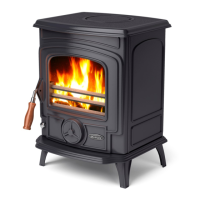10
DE-ASHING
Never allow the ashpan to over fill as it will cause
damage to the grate. Open the fire door (Part
No.21) and remove ashpan (Part No.12) using the
operating tool (Part No.34). Close the fire door (Part
No. 21). When the ash is disposed of, replace the
empty ashpan. (See Fig.8) Do not leave the fire
unattended with the fire door open, even for a
minute.
DISPOSAL OF ASH
Ashes should be placed in a metal container with a
tight fitting lid. The closed container of ashes should
be on a non-combustible floor or on the ground well
away from all combustible materials pending final
disposal. If the ashes are disposed of by burial in soil
or otherwise locally dispersed they should be
retained in the closed container until all cinders have
thoroughly cooled.
MAINTENANCE
CREOSOTE: Formation and Need for Removal
When some fuels are burned slowly, they produce
tar and other organic vapours, which combine with
expelled moisture to form creosote. The creosote
vapours condense in the relatively cool chimney flue
of a slow-burning fire. As a result, creosote residue
accumulates on the flue lining. When ignited cre-
osote makes an extremely hot fire.
CHIMNEY CLEANING
Chimney and connector should be cleaned at least
twice a year. Once before heating season and once
after. The chimney connector and chimney should
be inspected at least monthly during the heating
season to determine if a creosote build-up has
occurred. Remove the cast iron baffle plate (Part
No.15a) located at the top end of the firebricks (Part
No.s 13 & 14) before chimney cleaning.
When inspecting a masonry chimney, start at the
cleanout door, normally found at the base of the
chimney, or on the outside. If your chimney does not
have a clean-out door one should be provided.
REMEMBER COAL GASES ARE TOXIC.
WARNING NOTE
Properly installed, operated and maintained this
stove will not emit fumes into the dwelling.
Occasional fumes from de-ashing and re-fuelling
may occur. However, persistent fume emission is
potentially dangerous and must not be tolerated. if
fume emission does persist, then the following
immediate action should be taken:
(a) Open doors and windows to ventilate room
(b) Let the fire out or eject and safely dispose of
fuel from the stove
(c) Check for flue or chimney blockage and
clean if required.
(d) Do not attempt to relight the fire until the
cause of the fume emission has been identi-
fied and corrected. If necessary seek expert
advice.
The most common cause of fume emission is flue-
way or chimney blockage. For your own safety
these must be kept clean at all times.
Fig. 8
FIRE SAFETY
To provide reasonable fire safety the following
should be given serious consideration:
1. The installation of smoke detectors.
2. A conveniently located fire extinguisher to con-
tend with small fires resulting from burning
embers.
3. A practical evacuation plan.
4. A plan to deal with a chimney fire as follows:
a. Notify the fire department.
b. Prepare occupants for immediate evacua-
tion.
c. Close all openings into the stove.
d. While awaiting the fire department watch for
ignition to adjacent combustibles from over
head stove pipe or from embers or from
sparks from the chimney.
BRICK REMOVAL / REPLACEMENT
1. Remove fire fence (3 bars).
2. Remove protection plates located on RH & LH
side above roof baffle.
3. Lift up roof baffle, remove the front RHS brick,
tilting it down from the top edge.
4. While still holding up the roof baffle, remove the
front LHS brick, tilting it down from the top edge.
5. Lift the roof baffle forward but do not remove,
ensuring that the back brick is fully back against
the back casting and pushed fully to the LHS, pull

